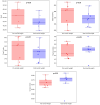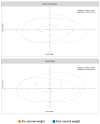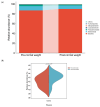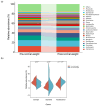In Search of Healthy Ageing: A Microbiome-Based Precision Nutrition Approach for Type 2 Diabetes Prevention
- PMID: 40507144
- PMCID: PMC12158179
- DOI: 10.3390/nu17111877
In Search of Healthy Ageing: A Microbiome-Based Precision Nutrition Approach for Type 2 Diabetes Prevention
Abstract
Background/Objectives: Type 2 diabetes (T2D) is a leading cause of morbidity and mortality worldwide and in Spain, particularly in the elderly population, affecting healthy ageing. Nutritional strategies are key to its prevention. The gut microbiota is also implicated in T2D and can be modulated by nutrition. We hypothesize that precision nutrition through microbiota modulation may help prevent T2D. This article aims to (1) describe a gut microbiota bacterial profile associated with T2D prevention, (2) provide precision nutrition tools to optimize this profile, (3) analyze how overweight influences the microbiota composition and precision nutrition response, and (4) address the technical challenges of microbiome-based precision nutrition clinical implementation to prevent T2D. Methods: A review of gut microbiota associated with T2D prevention was conducted. 13 healthy Spanish participants over 62 with optimal blood glucose levels (7 normal weight and 6 overweight) underwent a 3-month precision nutrition intervention to optimize T2D-preventive gut microbiota using a bioinformatics food recommendation system, Phymofood (EP22382095). Fecal microbiota was analyzed pre- and post-intervention using full-length 16S rRNA gene amplification, MinION sequencing, and NCBI taxonomic classification. Results: 31 potentially preventive bacteria against T2D were selected. The intervention increased the relative abundance of beneficial genera (Butyrivibrio and Faecalibacterium) and species (Eshraghiella crossota, and Faecalibacterium prausnitzii). The overweight influenced microbiota composition and intervention response. Conclusions: A gut microbiota profile associated with T2D prevention was identified, and precision nutrition could increase the relative abundance of beneficial bacteria. Confounding factors such as overweight should be considered when designing microbiome-based precision nutrition interventions. These results contribute to a better understanding of the microbiota associated with T2D prevention and address technical challenges for clinical implementation in future healthy ageing strategies.
Keywords: 16S rRNA gene; MinION sequencing; NCBI taxonomic classification; T2D prevention; bioinformatics food recommendation system; gut microbiota; healthy ageing; microbiome-based precision nutrition; overweight; type 2 diabetes (T2D).
Conflict of interest statement
The authors declare no conflicts of interest. Patent P22382095 is the property of the University of the Basque Country and the University of Cantabria, with A.G. and A.O. being among the inventors.
Figures






References
-
- World Health Organization (WHO) Life Expectancy at Birth (Years) [(accessed on 3 February 2025)]; Available online: https://data.who.int/es/indicators/i/A21CFC2/90E2E48.
-
- Welcome to IDF|International Diabetes Federation. [(accessed on 6 March 2025)]. Available online: https://idf.org/
MeSH terms
Grants and funding
LinkOut - more resources
Full Text Sources
Medical

